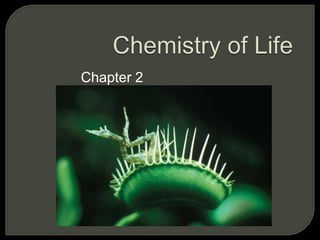
Honors ch2 notes 2013
- 1. Chapter 2
- 2. Organisms are chemical machines All organisms consist of atoms – Subatomic particles Electron (e-) – located in electron cloud Proton (p+) – located in the nucleus Neutron (no) – located in the nucleus Oxygen atom (O) Nucleus: 8 protons (+) 8 neutrons outermost energy level: 6 electrons (-) inner energy level: 2 electrons (-)
- 4. – Differ in the number of protons in the nucleus. – Number of protons = Number of electrons Elements are neutral on the periodic table – Atomic Number = Number of protons – Atomic Mass = Number of protons + Number of neutrons http://www.privatehand.com/flash/elements.html
- 5. Name Symbol # p+ # e- #no Tin 25 N 15 12
- 6. Differ in the number of neutrons they contain in the nucleus – Example: Carbon 12 – 6p+, 6e-, 6no Carbon 13 – 6p+, 6e-, 7no Carbon 14 – 6p+, 6e-, 8no
- 7. Chemical Bonding – Compounds are made of joined atoms of two or more different elements. Valence shell – outermost electron shell – Atoms with a full valence shell are inert (unreactive) – Atoms without a full valence shell can form bonds (reactive).
- 8. Name Symbol # p+ # e- #no Oxygen 6 K 53 - Why do all isotopes of an element have the same chemical properties? (Use your book to help you answer this)
- 9. The first electron shell of every atom can hold a maximum of 2 electrons. Each additional shell can hold a maximum of 8 electrons.
- 10. 1. Fluorine 2. Boron 3. Sodium
- 11. Covalent bonds – atoms share electrons – Ex: H2, O2, CO2 covalent bonds Oxygen atom (O) Carbon atom (C) Oxygen atom (O) Carbon dioxide (CO2 )
- 12. Ionic Bonds – atoms gain or loose electrons – Atoms form ions + charge – cation - charge – anion Ex: NaCl
- 13. Hydrogen Bonds – weak chemical attraction between polar molecules – Water is a polar molecule because the electrons of O and H are shared unequally.
- 14. Cohesion • Surface tension Adhesion • Capillary action Heat Capacity • A large amount of heat is required to increase the temperature of water
- 15. Water’s polarity gives it the ability to dissolve other polar molecules as well as ionic compounds
- 16. H2O H+ + OH- The pH scale indicates the concentration of H+ ions in a solution. • Acids – contain more H+ ions therefore have a pH below 7 The lower the pH the greater the acidity • Bases – contain more OH- ions therefore have a pH above 7 The higher the pH the more basic • Neutral – contain equal OH- and H+ ions
- 17. • 70% of your body is made of water. • The remaining 30% is made up mostly of organic compounds (Carbon-based molecules). – Carbon is a unique element because it forms four covalent bonds and can form a lot of different structures.
- 18. Many carbon-based molecules are made of many small subunits bonded together. – Monomers are the individual subunits. – Polymers are made of many monomers.
- 19. Key source of energy found in most foods Fruits, vegetables, and grains Made up of single sugars called monosaccharides. Glucose, fructose Disaccharides - two monosaccharides are joined Sucrose (table sugar) Polysaccharides – chains of three or more monosaccharides Starch, cellulose, glycogen
- 20. Polymer (starch) Starch is a polymer of glucose monomers that often has a branched structure. Polymer (cellulose) Cellulose is a polymer of glucose monomers that has a straight, rigid structure monomer
- 21. Nonpolar molecules not soluble in water Fats, phospholipids (make up the cell membrane), steroids (cholesterol), waxes Saturated fatty acids Solid at room temperature Butter, lard, grease Unsaturated fatty acids Liquid at room temperature Olive oil, fish oil
- 23. Formed by chains of linked amino acids Many functions including: Enzymes Structural (imbedded in the cell membrane) Antibodies
- 24. Formed by chains of nucleotides Two types : DNA (deoxyribonucleic acid) Double strand of nucleotides Stores hereditary information RNA (ribonucleic acid) Single strand of nucleotides Plays a key role in making proteins Nucleotide
- 26. Another important biological molecule ATP (adenosine triphosphate) – Consists of a single nucleotide with 2 extra phosphate groups. – ATP stores energy temporarily. – All cells require ATP to function.
- 27. Chemistry allows life to function! Everything living things do is possible due to chemical reactions The chemistry of breathing
- 28. Activation energy is the amount of energy that needs to be put in to start a chemical reaction.
- 29. Exothermic reactions release more energy than they absorb. – Excess energy is released by the reaction as heat.
- 30. Endothermic reactions absorb more energy than they release. – Energy is absorbed by the reaction.
- 31. – Proteins that increases the speed of a chemical reactions in cells – Act as a catalyst (reduces the activation energy needed in a reaction)
- 32. Any factor that changes the shape of an enzyme can affect the enzyme’s activity. – An enzyme’s function depends on its structure. – Denaturing (changing the structure) the protein by changes in temperature or pH – Example: pepsin